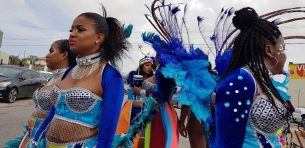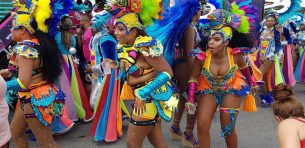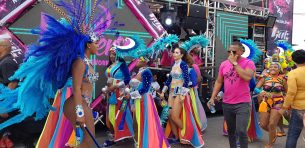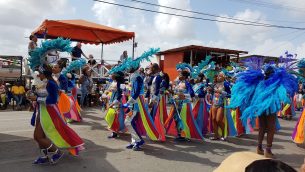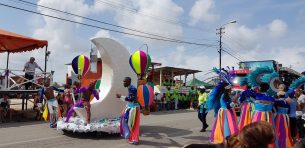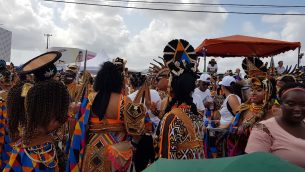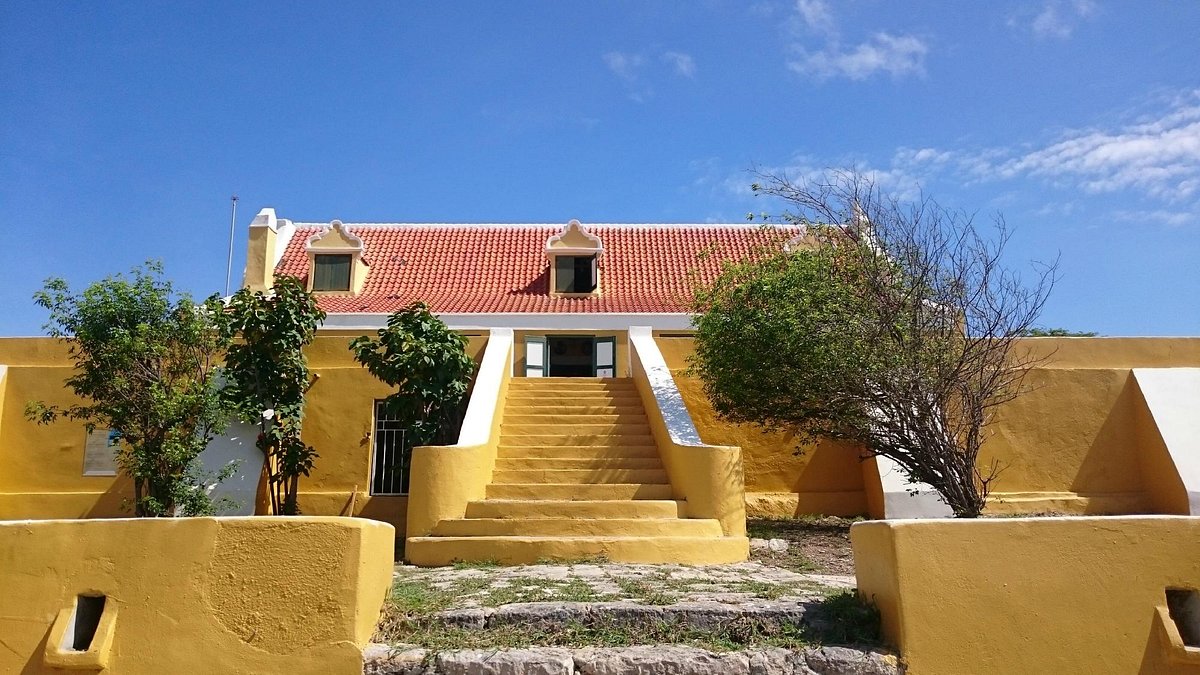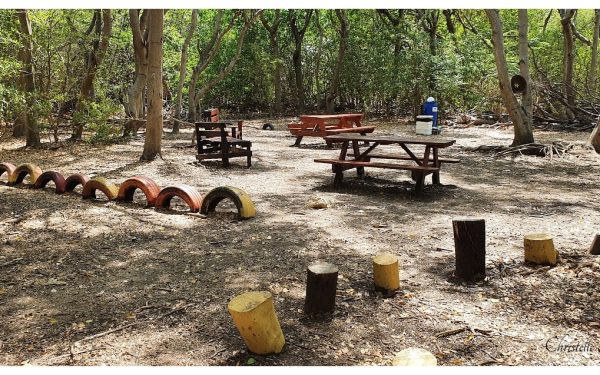Carnaval in Curacao

Carnival is a festive season that occurs at the close of the Christian pre-Lenten period, consisting of Quinquagesima or Shrove Sunday, Shrove Monday, and Shrove Tuesday or Mardi Gras.
Carnival is the most popular and longest lasting celebration on the island of Curaçao . The celebration takes place before the fasting period leading up to Easter and lasts two months with the highlight in the last week. The exact date of Carnival varies from year to year.
Because so many different cultures had come together on Curaçao, the festival underwent a special development. There were the Dutch colonists , the immigrants from Asian countries, the Creole middle class in the city, the people from the Eastern Caribbean islands and (the descendants of) the African slaves who all incorporated their own culture and traditions into the festival. Like the workers’ uprising of Trinta di Mei, according to anthropologist Rose Mary Allen it arose from the increasing self-awareness of the Afro-Curaçaoan identity. It is a festival of unity.
Carnaval 2019
Development
Although the roots of carnival can be found in Italy and France in the early Middle Ages, it took a long time before it became the popular festival in Curaçao as it is known today. The Catholic Church began an intensive mission to the Antilles in 1824 , but carnival as a widespread popular festival in Curaçao only started in 1961. Carnival celebrations have been known since the end of the 1940s. However, back then it was a festival of and for the elite. They were often small, private parties in a club setting to which you had to be invited.
In the late fifties, the desire arose among the people to take carnival out of the closed circuit. This took a lot of effort because it was initially forbidden to celebrate on the streets. In addition, there was resistance from the existing clubs: they wanted to continue celebrating their own parties. After much negotiation with the clubs and applying for permits, carnival for the entire population took place for the first time in 1961. Since then, it has become an indispensable part of Curaçaoan existence.
Carnival groups and their preparation
The various carnival groups provide a spectacular experience every year. When the carnival has just ended, they are already busy with the carnival for the following year. The preparations for the biggest party of the year require a lot of effort, energy and money and starting early is therefore necessary.
First, a theme is chosen. Once that has been determined, there is a brainstorming session about what to do with it and what the group wants to show with the theme. Then the costumes are designed: a male costume, a female costume and sometimes individual costumes. Once these designs have been made, the materials are purchased. It is not unusual to go to cities such as New York or Port of Spain ( Trinidad ). Once the fabrics have arrived, hundreds of people get to work making the costumes. All this happens over a period of months and in secret: no one wants the themes and costumes to be revealed before the day of the big procession.
Participating in carnival costs a lot of money. A normal costume easily costs nafl 800,-: about 400 euros. For a more special costume more has to be paid. And just a costume is not enough. Some people save a whole year to be able to participate. The groups have to make do with the money of their members and sponsors . If all that is not enough, fundraising activities are organized to collect money.
The celebration
The carnival lasts for about two months (often late January, February, early March) and is heralded by the election of the Prince, Pancho and Queen. The competition, organized by FUDEKA, is tough and the routes that the participants have to complete in advance require a lot of dedication. Prince, Pancho and Queen are elected in three groups: children, teenagers and adults.
Prince & Pancho
Prince & Pancho are always a duo. Someone does not just become Prince or Pancho. First, delegates are chosen within the carnival groups and schools. All duos have to give a presentation in which they present their message about carnival, show their creativity, show their originality and humor and prove how well they are attuned to each other. Once the groups and schools have decided who will be the delegates, the competition begins. The rules are strict, because being Prince & Pancho is not something you just do: during carnival they are the key bearers of the city and they open the official carnival.
Queen
Just like the Prince & Pancho, the carnival queens have to give a presentation. They also have to have a clear message. In addition, it is about appearance, quality and talent. Unlike the Prince & Pancho, the queens also have to wear their carnival costume and their appearance in a gala dress. The eventual carnival queen also goes to the summer carnival in Rotterdam and she competes for the title of International Queen of Carnival , a competition that was created by the island itself.
Court
Within the different titles, multiple prizes are awarded. For example, there is a Prince & Pancho who are the most dynamic, have the most talent, the first finalists and the title Prince & Pancho of the year. The same applies to the queen: in addition to the carnival queen of the year, the first and second finalists are also proclaimed, the most popular queen, the most sympathetic and the most talented.
Because these prizes are awarded within three groups (children, teenagers and adults), a whole court of Princes, Panchos and Queens is formed each year.
Honors and Prizes
Besides the fact that it is mainly about the honor, the winners also receive cash prizes and prizes that are made available by the sponsors. In addition to the Prince & Pancho and the Queen, groups can also win prizes. For example, those for the best float, the best decorated bar and the best costumes.
Tumba festival
After the Princes & Panchos and the queens have been chosen at the end of January, the tumba festival starts at the beginning of February. Tumba is a music style that is closely linked to the history of the Netherlands Antilles because it was brought by African slaves. Steel band music (instruments made of homemade stuff) has made way for tumba music, which has been designated as official carnival music since 1971.
The tumba festival, organized by music organization AMAK, lasts a week and is very popular among the inhabitants of Curaçao. During this festival, the carnival song of the year is announced. The winner receives the coveted king title Rei(na) di tumba . Since the eighties, there has also been a children’s tumba festival.
Children’s, teen and horse parade
Just before the main week begins, the children’s parade (primary schools), the teen parade (secondary schools) and the horse parade take place. Like the adult parade, this is all about the theme, the costumes and the beautifully decorated floats. The horse parade is also about the control and training of the horses.
-
Horse Parade
Carnival for the elderly
The elderly have also been considered. In the week of the carnival there is a day especially for elderly people who can no longer go and watch the carnival themselves. Music is played that people can sing along to and those who can still dance join in. This day was first organised in 2005 and around 350 elderly people attend each year.
The most important week
Once all the parades, elections and festivals have passed, the real carnival week begins at the end of February/beginning of March, with the Gran Marcha (the 6.5 km long parade for adults) playing the leading role since 1971. The entire island seems to come into action to cheer on the groups that have spent a whole year working on the floats, costumes, music and decorations. On average, about thirty groups of national and international origins take part. The big parade is a wonderful spectacle of colour and music and this sizzling street party with hours of exuberant dancing and singing is therefore the most popular part of the carnival.
Audience
In order to watch the carnival, it is necessary to buy a place along the side. There are special stands for tourists, residents can buy places where they can build and decorate. Often, homemade stands and carts are made from which people can watch the parade. These places are often a cozy gathering where people make music, play dominoes and barbecue. Often, it is already very cozy the evening before the big parade.
Farewell parade
The farewell parade, the Marcha di Despedida , is also popular. This parade, which takes place on the last evening, has an extra dimension because most groups decorate themselves and their floats with lights. The last hours of the carnival are all about shining on the streets.
Rei Momo
When the clock strikes twelve on the last evening, the Rei Momo doll is burned . This is an important custom: the way in which Rei Momo finally collapses carries a spiritual message. The Rei Momo contains fireworks, which gives the sad end of the carnival a festive touch.
